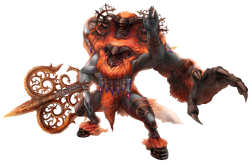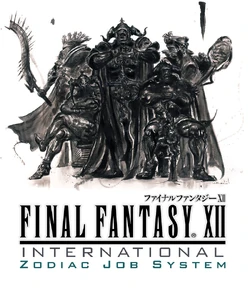Template:Sideicon Template:Infobox CVG Final Fantasy XII is the twelfth installment in the main Final Fantasy series and is part of the Ivalice Alliance. The game was released on March 16, 2006 in Japan, October 31, 2006 in North America, and February 23, 2007 in Europe and Australia. Final Fantasy XII is a single-player RPG.
Final Fantasy XII was re-released in Japan as an International Version with the subtitle Zodiac Job System, which modifies the game's character development system by introducing jobs. Zodiac Job System version hasn't been released outside of Asia.
Final Fantasy XII spawned a direct sequel, Final Fantasy XII: Revenant Wings, for the Nintendo DS.
Gameplay
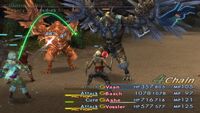
A battle in Final Fantasy XII.
As with each title in the Final Fantasy series, the specifics of each aspect of gameplay are different. Like most of the other games in the series, the player characters will level, gain skills, cast magick, use summons, Limit Breaks, and fight monsters. There are some great differences in the gameplay of Final Fantasy XII from the previous games in the series.
Character Development
To gain levels, the player must defeat enemies in the field to earn Experience Points (EXP). Only alive and active party members receive EXP from felled opponents. If there are multiple active characters in the party, the amount of experience points will be divided evenly. Boss battles give no EXP, but they do give License Points (LP). Defeating enemies also yields LP, which can be used to purchase licenses on the License Board to learn new abilities and become able to equip new types of equipment.
Unlike with EXP, even reserve party members receive LP from battles. An individual character's ability to use Technicks, Magicks, accessories, Augments, weapons and armor are governed by obtaining licenses. Like the Sphere Grid in Final Fantasy X, but less linear, the player has control over each character's individual development.
In the Zodiac Job System version what abilities a character can learn and what equipment they can use is dictated by their job. Once the player chooses a job for a character, it cannot be changed.
Magick
Magic is referred to as "magick". To use magick, the player must buy the individual spells from a Magick Shop or a merchant (or find them from treasures in the Zodiac Job System version), and once enough License Points are attained, they must purchase the corresponding skill on the License Board. The use of magick requires MP (Mist Points), which can be restored through movement, the use of an item such as an Ether, or by activating a Save Crystal.
Effect Capacity dictates how many magick spells and other special abilities can be executed simultaneously; all of the most powerful magicks use all of the effect capacity meaning when the player casts the game's most powerful magicks other actions are queued until the spell animation has finished.
Summons/Espers
Summons, called Espers, are obtained through battling and defeating them throughout gameplay. There are thirteen Espers; five are found through the storyline, and the other eight can be found in hidden areas after completing specific actions.
Each Esper can be purchased on the License Board after the player has defeated them during gameplay. Only one character can purchase any specific Esper, and that Esper is linked to that character, removing its license from the other characters' License Boards. When the character summons the Esper, it takes the place of the other two members of the party. The Esper will remain and fight independent of the character for a short amount of time, as long as the summoner is still conscious.
Once the time is up, the Esper will unleash a special attack, given that the requirements for the attack are met, and disappear. The summon uses up a full segment of the MP bar for each rank the Esper has. For example the Esper Belias is a Rank I Summon and will use up one segment of the MP bar, while Zodiark, a Rank III Esper, will use up all three segments.
In the Zodiac Job System version Espers have a small role in further governing what skills characters can learn by opening new paths in the License Board. The MP bar system has been dropped and using Quickenings and summoning Espers uses a different gauge. The Espers are controllable in the Zodiac Job System version, and the player can unleash their special attack at will.
Quickenings/Concurrences
The Limit Breaks in Final Fantasy XII are known as Mist Quickenings in the English version, and Mist Knacks in the Japanese version. Each Quickening is available on the License Board for purchase by any character. Once a character has purchased a Quickening, that space is removed from all other characters' boards. Each character can purchase up to three Quickenings.
There are eighteen Quickenings on the board. When a character uses a Quickening, one segment of their MP is used up. Upon purchasing the second Quickening the character's MP bar doubles and is segmented in two, and after a third segment is added it triples the available base MP. Each Quickening takes 50 LP to learn regardless of its rank.

Basch's Level 1 Quickening, Fulminating Darkness.
Quickenings can be used during battle as long as the character has enough MP. Quickenings can be chained: when used, all active party members who have learned Quickenings of their own will join in on the chain as long as they are not KOed, under X-Zone, or afflicted with either Stop, Stone, Disable, Confusion, SilencedIn the International Zodiac Job System version, since Mist command no longer draws from the user's MP and instead uses a separate Mist gauge, a character afflicted with silence can use Mist abilities such as Quickening and Summon, or Berserk. During the chain, the player can randomly get the Mist Charge command which restores the party member's MP. The chain-building is restricted by the time limit and luck, as the available Quickenings are drawn up by random. Normal Quickening attacks only damage the target enemy, but the player can create a specific combination of Quickenings to open a Concurrence, which deals heavy damage to the target and all targets nearby.
In the International Zodiac Job System version, Quickening no longer uses MP, but has a gauge that functions closer to how Limit Breaks work in other games in the series. This meter can be filled up slowly by participating in battle, or fully by using Elixir/Megalixir, or activating a save crystal. Each job has four Quickening licenses costing 50, 75, 100, and 125 LP. Once three Quickening licenses have been activated, the remaining one will disappear from the board of that character.
Battle
Template:See Also
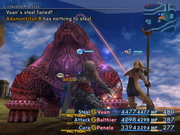
Vaan, Penelo and Balthier fighting an Adamantitan.
Final Fantasy XII uses a battle system called Active Dimension Battle (ADB). The way the battle system operates is similar to the one in Final Fantasy XI as there are no random encounters. Monsters move freely across the landscape and battles are conducted on the field map without transition. Enemies rarely surprise the party, although flying creatures attack from a higher elevation, and other creatures will spring out of the water or ground to attack. Docile monsters can become hostile if the party provokes them, such as by casting magick in their vicinity, or if the player attacks other creatures of the same genus.
Combat can be controlled manually or programmed via the use of gambits. The gambit system is slightly similar to the Macro system in Final Fantasy XI; the player can create a list of commands and dependencies to be carried out automatically by the characters to simplify the combat system. All commands relate to the character itself, the character's allies, or the enemies on screen.
Player can choose between Wait mode (default) and Active. In the Wait mode time freezes when the player is choosing the commands, but only one action can be executed at a time. If the game config is set on Active, multiple actions can be executed simultaneously, as long as the Effect Capacity is not saturated. The player controls one character at the time, called the party leader, but the player can change party leader at any time. If the party leader is KO'd or otherwise incapacitated, the game prompts the player to choose another leader. The player can have up to three party members at any one time, and the rest are kept in the reserve party.
Similar to Final Fantasy X, reserve members can be swapped in any time, unless the character is currently being targeted by an attack or spell or if the character is performing an action. Final Fantasy XII allows the player to swap even fallen allies, meaning the player will only get a Game Over once all party members in both active and reserve parties are dead.
Because battles take place on the fields, the Escape command works differently than in most other games in the series; to escape from enemies the player must run away, which can be aided by holding the Template:PS R2 button to stop all character actions (although using this feature makes the characters unable to evade enemy attacks). Some enemies stop pursuing the player characters once they have moved far enough away, but some are more persistent and can only be thrown off by zoning out. Boss battles take place in closed arenas and cannot be escaped from.
Battle Chain

The largest loot drops from the enemy after continuously killing the same type of enemy.
A Battle Chain is initiated when a party defeats two or more of the same type of enemy in a row. The Battle Chain Level will increase as a party continues to consecutively defeat enemies of the same type.
As the Chain Level increases with each battle, enemies will begin to drop rarer and multiples of items, and with higher levels, activate healing and buffs on the player's party. If the player kills an enemy of a different type, enters a settlement (any area where only Vaan is controllable) or touches a Save Crystal, the chain will break and the Chain Level reset to 0.
Traps
Traps are littered across the landscape and when stepped on deal damage and/or inflict the party with status ailments. Traps are normally invisible, but appear as glowing red circles if a party member is under Libra. Traps can be avoided by using Float or the Steel Poleyns accessory that makes the party invulnerable against traps. Some traps benefit the party by granting positive status effects and/or healing the party's HP.
Treasures
Unlike in other single-player games in the series, the treasures in Final Fantasy XII are most often randomly spawning containing random treasures. The treasures can be re-spawned by zoning two zones out. Treasures can contain gil, gambits, equipment or items, and there is a small chance of receiving rare treasure with the Diamond Armlet equipped.
The game's regular version also has so called "forbidden chests" that, when claimed, prevent the player from obtaining the game's ultimate spear, the Zodiac Spear, in Necrohol of Nabudis. This feature was removed in the International version.
Weather and Terrain
The area's weather and terrain affect the accuracy of ranged weapons and the damage dealt by elemental attacks. In stormy weather crossbows' and bows' accuracy is reduced, and, for example, in rainy weather Lightning damage is boosted while Fire damage is reduced. While terrain is mostly fixed, apart from the Giza Plains that shifts between dry and wet season, weather is often random, depending on what possible weather effects are available for the area.
Setting
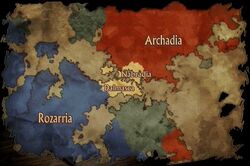
Ivalice.
The world map of Ivalice does not cover the entire world. It shows the area once under the control of the Dynast King Raithwall, but now mostly under the control of the Archadian and Rozarrian Empires.
On the map are the kingdoms of Dalmasca, Archadia, Bhujerba and the area once controlled by the Kingdom of Nabradia including Nalbina Fortress. The player can visit ancient temples like the Stilshrine of Miriam, Mt Bur-Omisace and the Tomb of Raithwall, as well as the village of indigenous people like the garif and the viera. Between all of these civilized locations are the zones patrolled and populated by various monsters. Each location is separated into zones, to allow players to elude monsters, and to allow for variations in terrain even in the same area.
The Archadian and Rozarrian Empires compete in terms of military and political influence. The Archadian Empire is governed by the ruling family House Solidor, with an Imperial Senate, but during the time of Final Fantasy XII the Senate has little power. This has caused the Archadian Judges to serve the Emperor directly. The Judges command the Archadian Army, Archadian Imperial Fleets, Archadian Security and Police as well as the Archadian Intelligence. The Archadian Judges are feared and respected for their passion for the Empire and the defense of House Solidor from the corrupt political scene.
Vayne Carudas Solidor attempts to initiate a war with the Rozarrian Empire. Vayne's quest for power splits the Archadian Judges, as Judge Bergan remains Vayne's key follower but Judge Drace wants Vayne arrested and put on trial for High Treason.
Characters
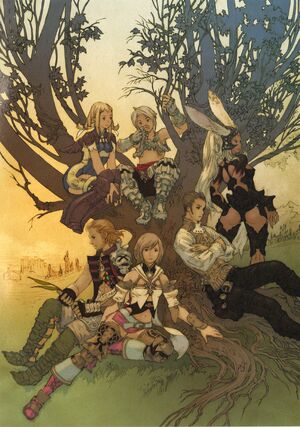
Art of the Main Playable characters in Final Fantasy XII by Akihiko Yoshida.
Final Fantasy XII has a cast of six main characters. Unlike other Final Fantasy games, this team, once formed, never changes. Three guest characters (not including Hunt-allies) join the party during the story, and the player plays a different character during the prologue. According to the developers, there is no main character, as the game is "about numerous people, not just one person".[1]
Main cast
- Vaan is a street urchin and an orphan who lives on the streets of Rabanastre with his friend Penelo. He dreams of becoming a sky pirate in command of an airship and to travel the world.
- Penelo is Vaan's closest friend, an orphan who lost her family during a war between Dalmasca and Archadia. She dreams of being a dancer, and learned martial arts from her older brothers who were soldiers who served during the war. She joins the party along with Vaan to help prevent another war.
- Balthier, real name Ffamran mied Bunansa,[2] is a sky pirate on the run from his past. He refers to himself as the "leading man".
- Fran is Balthier's friend and partner, and as a viera, the only non-hume main character. Like Balthier, she is trying to shake off the past. She rarely speaks, but she usually has words of wisdom to offer.
- Basch fon Ronsenburg is a disgraced knight, who wants to protect his surrogate homeland of Dalmasca. He was branded a traitor when he was framed for a murder.
- Ashelia B'nargin Dalmasca is the princess of Dalmasca who does everything in her power to rebuild her fallen kingdom. She was married to Lord Rasler, Prince of Nabradia, and although their marriage was politically motivated, they nevertheless were in love. Rasler commanded the Dalmascan army to battle with Archadia but was killed by an archer. Ashe faked suicide to sow seeds of rebellion against Archadia.
Temporary playable character
- Reks is Vaan's older brother, who fought in the Dalmascan Army.
Guests
- Larsa Ferrinas Solidor/Lamont the youngest member of House Solidor, the ruling family of Archadian Empire. He seeks to bring peace to the world.
- Vossler York Azelas used to fight alongside Basch in the Dalmascan army, but after the war's end joined the rebellion. He's been looking after Ashe ever since she faked her suicide.
- Reddas is a sky pirate from the Balfonheim Port. He seeks to stop the Empire from using nethicite to prevent the events of Battle of Nabudis from ever happening again.
Story
Background
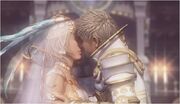
Princess Ashe and Prince Rasler are married.
The Kingdom of Dalmasca is a small city-state in the world of Ivalice, a neutral party in the past wars between the neighboring Empires of Archadia and Rozarria. Dalmasca was conquered by Archadia and reduced to the status of an occupied state when its King Raminas signed the city into Imperial rule.
Formerly-loyal knight Basch fon Ronsenburg murders the king for his betrayal. Witnessing the betrayal is the young knight Reks, who reveals Basch's betrayal in his last breaths. Marquis Ondore, head of the sky city Bhujerba, announces the King's daughter, Ashe, has committed suicide after her newly-wed husband, Lord Rasler, was killed during the Battle of Nalbina Fortress. He announces Basch has been executed for high treason.
Misadventures of Vaan

Balthier and Fran ambush Vaan in the Palace treasury.
Two years later, Reks's brother, Vaan, an orphaned street urchin living in the Dalmascan capital of the Royal City of Rabanastre, is stealing treasure from the Archadian Consul's residence in the old Royal Palace of Rabanastre. While looting the Goddess's Magicite from the vault, Vaan meets Balthier, a sky pirate bent on stealing the Consul's treasures, and his companion Fran, a viera warrior and Balthier's partner.
The underground Dalmascan Resistance movement assaults the royal castle on the same night in a military coup to remove the Archadian Consul, Vayne Solidor. Vaan, Fran, and Balthier are pursued by Archadian soldiers and they escape into the Garamsythe Waterway where they meet the surviving princess of Dalmasca, Ashe, under the alias Amalia, who is also the leader of the resistance faction.

Basch imprisoned in the Nalbina Dungeons.
The group is captured by the Imperial Guard, under the assumption they are thieves. Ashe is escorted away, and not so far from the scene a group of bounty hunters note the guard capturing their mark. Balthier, Vaan and Fran are sent to the Nalbina Dungeons from whence they escape, bringing Basch, revealed to be alive and imprisoned since the war, with them.
Basch reveals he has a twin brother, Gabranth, who stole his identity and murdered the king to blackmail Ondore and strip Dalmasca of sovereignty. The bangaa headhunter Ba'Gamnan and his group, who are looking for Balthier, kidnap Vaan's best friend Penelo under the assumption she has a connection with Balthier who would thus come to her aid.
Balthier, through coercion from Migelo, Vaan and Basch travels to Bhujerba to free Penelo. They meet Larsa Solidor traveling under the alias "Lamont," posing as a commoner, who is seeking what turns out to be manufacted nethicite. Larsa is the younger brother to Consul Vayne, and the second in line for the throne of Archadia. He helps the party rescue Penelo, and later keeps her and the party safe from Archadian troops.
Seeking Power
The party seeks an audience with Marquis Ondore, who is a secret supporter of the Resistance although on the surface allied with the Empire. He sends the party to the Arcadian warship, the Dreadnought Leviathan, to rescue "Amalia". The party retrieves Ashe and escape and Vaan is reunited with Penelo. Afterward, the group has another meeting with the Marquis, where Ashe requests Balthier's aid to retrieve a proof of her royal blood: the Dawn Shard, so that she can assume Dalmasca's throne.

Ashe vows to use the Dawn Shard as her weapon to fight the Empire.
The party heads to the Dynast King Raithwall's Tomb to retrieve the Dawn Shard, and are captured by Judge Ghis upon leaving the tomb. A mysterious explosion provides opportunity for the party to escape and during their escape, they witness the Leviathan and the entire Archadian Eighth Fleet destroyed by the power of the Dawn Shard, which is composed of a powerful substance called deifacted nethicite.
Bent on wielding that power to free Dalmasca and avenge her fallen comrades, Ashe heads to Jahara to learn more about the stone, but the garif tribe tell her they cannot help due to the stone eluding even their ancestors - however, the Dynast King once wielded it. They meet Larsa who persuades Ashe to join both him and another mysterious enemy/ally at Mt Bur-Omisace to plan how to stop the imminent war.
Disgraced by the Eighth Fleet's destruction, Vayne is called back to Archadia, and begins to suspect his father, Gramis Gana Solidor, and the Imperial Senate will bypass him for Emperor, giving the throne to his brother Larsa instead. Unwilling to risk this Vayne murders his father, dissolves the Senate, and sends a ship to Mt Bur-Omisace to take the Dawn Shard from Ashe. His envoys, Judges Bergan and Zargabaath, arrive too late: Ashe and Larsa have heard of the events and Ashe has obtained the Sword of Kings, a sword that can destroy nethicite. Judge Zargabaath takes Larsa to Archades, while an enraged Bergan kills the holy man Gran Kiltias Anastasis and bombs Mt Bur-Omisace, but dies unable to retrieve either the shard or the sword.
Ashe is enigmatized by the Occuria's request.
Ashe and her party decide to destroy all the nethicite available in Ivalice, so they head to the Draklor Laboratory in the Archadian Empire to destroy the last remaining shard in the possession of Dr. Cid, Balthier's father. They are unsuccessful in destroying the nethicite in the Draklor Laboratory, and are left with information pointing them to the Ancient City of Giruvegan where Dr. Cid is supposedly heading to retrieve more deifacted nethicite. The party enters the city and fights to the center of the Great Crystal where the Occuria live.
The history of Raithwall and nethicite is revealed. Ashe is given the Treaty-Blade to carve out additional pieces of deifacted nethicite from the Sun-Cryst, the source of all nethicite power, to achieve power enough to destroy Archadia and its benefactor, the rogue Occuria Venat. She is conflicted as to her course of action.
Ashe and the party leave Giruvegan with the knowledge that Dr. Cid has used them to retrieve the Treaty-Blade, and had no intention of traveling to Giruvegan. They head for Balfonheim where Reddas joins the party to travel to the Ridorana Cataract, where the Sun-Cryst is housed in the Pharos lighthouse.
In the lighthouse Ashe realizes the appearances of Lord Rasler she has been seeing are images constructed by the Occuria to manipulate her actions. Judge Gabranth briefly fights the party but upon his defeat, Dr. Cid appears and banishes him back to the fleet, taunting Gabranth for his failure. Cid fights the group, using the Esper Famfrit to aid him. Upon defeating Dr. Cid, the Sun-Cryst begins to overload but Reddas sacrifices himself to destroy the Sun-Cryst with the Sword of Kings.
Battle in the Bahamut

The Battle above Rabanastre.
Vaan's party return to Balfonheim, and learn the discharge of Mist from the Sun-Cryst activated the largest airship ever built, the Sky Fortress Bahamut, and the Resistance armies are staging a battle in the skies above Rabanastre. They travel to the Bahamut to stop Vayne before the conflict will destroy Rabanastre. Before they reach Vayne, Gabranth arrives to stop them.
Gabranth has given up everything except his need to destroy his brother. The party defeats Gabranth, and leave him beaten in the elevator. Vayne attacks, and Larsa helps the party fight him. As Vayne is beaten his manufacted nethicite sucks power away from Larsa, and the ship around him.
Gabranth joins the attack against Vayne, but is struck down, just as Vayne is mortally wounded. Vayne limps away from the battlefield onto an outer platform on the Bahamut and calls for Venat, telling the Occuria that he (Venat) must seek another to realize his ambitions of freeing Ivalice from the Occuria's tyranny. Venat says that by destroying the Sun-Cryst the Age of Stones is now over, and the Occuria have lost their influence on Ivalice's fate - thereby fulfilling Venat's desire. Venat dissolves, investing Vayne with its power as an Undying. He absorbs pieces of the fortress onto himself.
Vayne is defeated and explodes into a cloud of Mist. The party must stop the warring factions from killing each other and stop the Bahamut falling on Rabanastre. Boarding the Strahl, the party makes its escape, and with Larsa, Ashe, and Basch's help (the latter posing as Gabranth), manage to get both sides to stand down. The Bahamut begins to fall from the sky, and Judge Zargabaath wants to place the Alexander on a collision course, hoping to ram it out of the way.
Balthier and Fran are still on the Bahamut and restart the engines and Balthier tells Vaan to look after the Strahl while he is gone. Vaan assures Balthier that he will, before the Strahl flies away and the Bahamut crashes outside of Rabanastre.
Epilogue
A year later Penelo is writing a letter to Larsa. Dalmasca, Archadia, and Rozarria are currently at peace, and the party has split, each living their separate lives. A month from now, Ashe will be crowned Queen of Dalmasca, so they will not be able to see her anymore. A few months prior the Strahl was stolen, but Penelo notes it is not really stealing if the original owner took it back.
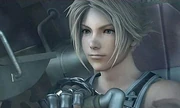
Vaan sets off to meet with Balthier in his new airship with Penelo.
Balthier left behind Ashe's ring, which she gave to him as compensation for the treasure Balthier did not get in Raithwall's Tomb. Basch took over his late brother's place as Judge Magister and Larsa's protector, with the Council never learning of Gabranth's death. Vaan flies his new airship to find Balthier, with Penelo accompanying him, where the sequel Final Fantasy XII: Revenant Wings picks up.
Development
Developed from 2001 to 2006, Final Fantasy XII cost approximately 4 billion Japanese yen (35 million USD) to produce with a crew of more than one hundred people. Yasumi Matsuno, originally announced as both producer and director, bowed out of both roles midway. The official reason given for his departure was health concerns. On February 25, 2010, Matsuno spoke out on his departure from the Final Fantasy XII project on his Twitter page, stating that while he had been sick, he had nevertheless let down the Square Enix staff, shareholders, and fans who had been looking forward to the game.
In Matsuno's place, Hiroyuki Ito and Hiroshi Minagawa took over directorial duties, with Akitoshi Kawazu assuming the role of the executive producer. Matsuno remains credited for "Original Work/Scenario Plot/Supervision". Hitoshi Sakimoto composed the game's music while Nobuo Uematsu contributed a single composition — the vocal theme, "Kiss Me Good-Bye", performed by Angela Aki. Renowned violinist Taro Hakase provided performances for "Symphonic Poem "Hope", which served as a promotional theme along with "Kiss Me Good-Bye".

Early gameplay development of Final Fantasy XII.
The executive producer, Akitoshi Kawazu, has said in an interview[3] that back in 2000 when Final Fantasy X, Final Fantasy XI and Final Fantasy XII were announced as being in the planning stages, Final Fantasy X was announced as an offline game while the games Final Fantasy XI onwards would be online games. During the development of Final Fantasy XII that changed, but, just from the early planning stages the team intended Final Fantasy XII to be a different experience from Final Fantasy X.
In early stages of development the main character was to be "big and tough", but as development continued and targeting demographics were considered, he became more youthful. With the casting of voice actor Kohei Takeda, who also did motion capture for the part, he became less so and more "active, upbeat, bright and positive".
Hiroyuki Ito was in charge of creating the battle system and his motivation for the gambit system was to create a "single-player online game" where the player would have independently acting party members who would still act the way the player wanted them to. The gambit system works on the same basic programming algorithms used for the monsters in the SNES Final Fantasy games.[4]
Final Fantasy XII was initially planned to have a job system but the idea was scrapped when the developers thought it might be too confusing to players, so the idea was condensed into a License Board system. However, players did not respond to the License Board system as anticipated, and the team went back to their previous idea of using a job system in the Zodiac Job System version.[5] One intended theme for the gameplay was to add a feeling of finality and destiny, where the player may or may not end up with the best results.
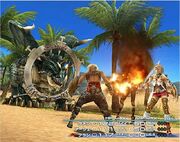
Early gameplay development of Final Fantasy XII.
This is reflected with the random treasure chests, as well as perhaps the fact that the game's ultimate weapon is easily missed. The developers did not intend players to unlock every license for every character, but plan different paths for each. In retrospect these ideas did not end up working as planned, as many players kept trying at the same treasures until they got the item they wanted, and many players unlocked all licenses in order, essentially making the player characters clones of each other.[5] Some of these ideas were rectified in the Zodiac Job System version.
Veteran translator Alexander O. Smith was involved with script's English localization. Smith had previously worked on the localization for Vagrant Story as well as several other Final Fantasy installments, including Final Fantasy X. The voice overs were directed by Jack Fletcher, who had previously directed the voice overs for other Final Fantasy games.
Almost an entire year before Final Fantasy XII's North American release, the game's playable demo was included along with the North American release of Dragon Quest VIII. Changes to the game's North American version include the addition of widescreen 16:9 support, and additional scenes and content that were left out of the Japanese version, due to rating issues.
Akitoshi Kawazu, the game's executive producer, has later admitted he thought the game is not perfect. The team received fan feedback after the game was released in Japan, and there were players who felt the story wasn't up to the series' standards. Kawazu said it is because of the way the games are made, the story itself is decided early on and the process of getting that realized makes it difficult to change along the way. Kawazu noted there are things he personally would have liked to change, but, practically speaking, they couldn't.[6]
Final Fantasy XII International Zodiac Job System
Final Fantasy XII International Zodiac Job System was released on August 9, 2007 in Japan as part of both Final Fantasy 20th anniversary and Ivalice Alliance campaigns. It is the first game where Hiroyuki Ito has been credited as both producer and director.
Ito didn't want the game to get an "International" title, for how different the game was going to be from the other International versions of Final Fantasy games, published previously; Ito wanted to call the game "Final Fantasy XII Annex".[5] However, they ended up going with "Zodiac Job System". Final Fantasy XII International Zodiac Job System was made by a small group of programmers, with only five main people working on it toward the end of the project. The small team brought on some limitations on what could be achieved, as Ito would have wanted bigger changes to the game than what could be done with the resources he had available.[5]
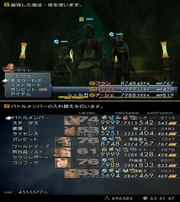
The field and status screen in widescreen 16:9 ratio of Zodiac Job System. Notice the minor changes of interface compare to the original version.
The game includes a new take on the License Board system, with twelve grids instead of one, each corresponding to a different Zodiac sign and job. The number of jobs was set at twelve as Final Fantasy XII is the twelfth main installment to the series, and because there are twelve Zodiac signs, a recurring theme in Ivalice games. The game already had fifteen different types of weapons in place, and the jobs were planned around the idea that what kind of weapon would belong to what kind of job.[5]
The battle system was tweaked; guest characters were made controllable, while pressing the Template:PS L1 button button accelerates the game's speed. The game features English voices and the widescreen 16:9 ratio support of the North American version, as well as a bonus disc based on the one initially released with the North American version. A new mode allows the player to hunt monsters and Espers in several series of small maps, to gain items and gil.
A list of new features as below:
- The Zodiac Job System – There are now twelve License Boards, each one representing a job. Once a character chooses a job it cannot be changed. Isolated licenses can be accessed by unlocking Espers and Quickenings.
- Trial Mode – The party must fight through 100 stages, each one containing stronger monsters. Completing this mode unlocks New Game+: Weak Mode.
- Controllable Guests – Guest characters can now be controlled, their gambits can be edited, and can level up. Their equipment cannot be removed.
- Controllable Espers – Espers can be controlled once summoned, and their gambits can be edited. The player can use their ultimate attack at will.
- Speed Boost – Pressing the Template:PS L1 button speeds up the game, making getting around faster. The music and cutscenes still play at normal speed.
- Gambit Changes – There are 16 new gambits. All the gambits can be bought upon leaving Barheim Passage.
- Stat Growth Changes – Each character's stat growth has been altered slightly.
- Item Changes – New items have been added, and some of their effects have been slightly changed.
- Enemy Changes – Enemies have been changed slightly, plus new enemies have been added. A battle against all five Judge Magisters is also included.
- Magick Changes – Water and Watera are renamed to Aqua and Aquara. Many spells have been re-categorized; Bravery and Faith are now White Magick for example. Cure and all tier 1 Black Magick elemental spells have an area of effect (same as their higher tier counterpart) instead of targeting only a single unit. Not all magick can be bought, and some must be found in treasure chests.
- Equipment Changes – New weapons have been added, like the Excalipoor, while others have been slightly changed. Armor and accessories have also been slightly changed. Some weapons have different elemental alignments.
- Shop Listings – Some shops have had their inventory changed.
- Hunt Reward Changes - Rewards for defeating Marks have slightly changed.
- Mist Knack (Quickening) Changes – Mist knacks no longer take up MP. Instead, they have their own Mist gauge.
- MP Changes – Since Mist Knacks do not use MP now, obtaining Mist Knacks does not increase MP. Instead, characters simply get more MP as they level up. Max MP is determined by the character's job.
- New Game+ – Two New Game+ modes are available. Strong Mode, where all characters begin at level 90, and Weak Mode, where all characters begin at level 1 and never level up. Nothing carries over into these new save files.
- Treasure Respawns – Treasures pots now respawn by just moving one screen away.
- Treasure Item Changes - Some items inside coffers have been switched around, added, or removed.
- Break Damage Limit – There is no damage limit anymore. If a character does more than 9,999 damage, the game will show it. Against weak enemies, it is possible to achieve over 100,000 HP of damage with a single attack. This gives the strongest magick spells greater potency to rival melee attack with high hit combo.
Also, unlike Final Fantasy X-2 International, which supported old Final Fantasy X-2 save files, Final Fantasy XII International Zodiac Job System does not support save files from the regular Final Fantasy XII.
Final Fantasy XII International Zodiac Job System has only been released in Japanese, but there is a fan project that translates it to English using the English data of the official US release. It requires both the original Final Fantasy XII International Zodiac Job System game and the original US release. Translation for other languages can be done using official European releases instead of the US release. [1]
Themes
The prominent theme in Final Fantasy XII is coping in the face of loss of family. Vaan loses his parents, and then his brother Reks in the war between Dalmasca and Archadia at the hands of Gabranth, thus giving Vaan an animosity towards the Archadian Empire. Like Vaan, Penelo loses her family to the war leading her to fear the empire. Her view slowly changes as her friendship with Larsa develops, a member of the empire's ruling family.
Ashe loses her husband, father, and kingdom to the Archadian Empire, and avenging them is her main motivation. Ashe's quest for revenge is used by the Occuria, who use a false apparition of her late husband Rasler to spur her thirst for revenge to use her to achieve their own ends. Ashe learns that exacting revenge is not something Rasler would have wanted her to do, and it will not bring him or her father back.
The theme of freedom is strong in Final Fantasy XII. Basch is physically imprisoned but breaks free with the party's help, but later comments the past can bind a man as strong as chains. Multiple characters seek to escape their past, only to find they must face it sooner or later. Fran leaves the woods to gain her freedom of the viera's traditionally restrictive lifestyle, but in doing so is permanently cut off from her family.
Balthier escapes an unbearable situation with his father by renouncing his identity, only to find he must confront his father's madness to move on. Vaan tries to obtain his freedom through becoming a sky pirate to explore the world as he pleases, but realizes it's his attempt to evade his problems. Ashe wishes to reclaim her throne and kingdom, and be free from the Empire's rule once and for all, but first has to overcome her hatred for the empire and the role it played in robbing her of her loved ones and the downfall of the Dalmascan kingdom.
Like with much of the games set in Ivalice, Final Fantasy XII has deconstructive elements regarding religion and theism on the social and human condition. The gods of Ivalice are revealed to be mere living beings, and even the truths of Raithwall are shown to be their machinations to enact their own plans. Although Man is shown to be allowed his own fate, free from the gods, Archadia is shown as those of the path should mankind undertake one of evil with this freedom, undergoing tyranny and dominance over others. Kiltia is shown as a religion in modest balance and order.
Production credits
Staff
| Executive Producer | Akitoshi Kawazu |
|---|---|
| Producer | Hiroyuki Ito |
| Directors | Hiroyuki Ito Hiroshi Minagawa |
| Game Design & Battle System Director | Hiroyuki Ito |
| Visual Design & Character Texture Supervisor | Hiroshi Minagawa |
| Main System & Event Programmer | Takashi Katano |
| Lead Realtime Rendering Programmer | Yoshinori Tsuchida |
| Programming Supervisor | Taku Murata |
| Main Character Design & Background Design Supervisor | Akihiko Yoshida |
| Art Direction | Hideo Minaba, Isamu Kamikokuryo |
| Visual Effects Director | Jiro Mifune |
| Background Visual Effects | Yoshinori Ogura |
| Lead Motion Designer | Takeo Suzuki |
| Event Motion Designer | Hiroaki Saotome |
| Hi-Polygon Facial Models & Textures | Takahiro Matsuhira |
| Hi‑Polygon Facial Motion | Takeshi Sadohara |
| Battle System Design | Kazutoyo Maehiro |
| Event Director & Scenario Director | Jun Akiyama |
| Scenario | Daisuke Watanabe, Miwa Shoda |
| Dialogue | Kyoko Kitahara |
| Lead In‑Game Event Designer | Takeshi Iwabuchi, Masahiro Kataoka |
| Lead Map System Designer | Kazuhiro Kataoka |
| Lead Menu System Designer | Yuichi Murasawa |
| Sound Effects Director | Tsuyoshi Okahisa |
| Movie Direction | Eiji Fujii |
| Image Illustration | Yoshitaka Amano |
| Music Production & Composition | Hitoshi Sakimoto |
| Story & Concept | Yasumi Matsuno |
| Lead Production Coordinator | Hiroaki Kato |
| General Manager | Masashi Hiramatsu |
| Translators | Alexander O. Smith, Joseph Reeder |
| Editor | Morgan Morris Rushton |
Voice Cast
| Character | Japanese | English |
|---|---|---|
| Vaan | Kouhei Takeda | Bobby Edner |
| Penelo | Yuna Mikuni | Catherine Taber |
| Ashelia B'nargin Dalmasca | Mie Sonozaki | Kari Wahlgren |
| Balthier | Hiroaki Hirata | Gideon Emery |
| Fran | Rika Fukami | Nicole Fantl |
| Basch fon Ronsenburg | Rikiya Koyama | Keith Ferguson |
| Reks | Hideki Tasaka | Yuri Lowenthal |
| Larsa Ferrinas Solidor | Yuka Imai | Johnny McKeown |
| Vossler York Azelas | Masaki Terasoma | Nolan North |
| Reddas | Takayuki Sugo | Phil LaMarr |
| Vayne Carudas Solidor | Nobuo Tobita | Elijah Alexander |
| Judge Gabranth | Akio Otsuka | Michael E. Rodgers |
| Judge Bergan | Yōsuke Akimoto | Gary Martin |
| Judge Drace | Yoko Soumi | Julia Fletcher |
| Judge Ghis | Ryunosuke Obayashi | Mark Wing-Davey |
| Judge Zargabaath | Ryuzaburo Otomo | Simon Templeman |
| Emperor Gramis Gana Solidor | Hidekatsu Shibata | Roger L. Jackson |
| Doctor Cidolfus Demen Bunansa | Chikao Otsuka | John Lee |
| Lord Rasler Heios Nabradia | Yasuyuki Kase | Andrew Philpot |
| Migelo | Shiro Saito | John DiMaggio |
| Al-Cid Margrace | Norio Wakamoto | David Rasner |
| Marquis Halim Ondore IV | Akio Nojima | Tom Kane |
| Ba'Gamnan | Koji Ishii | Steve Blum |
| Jote | Yoshiko Sakakibara | Michelle Arthur |
| Mjrn | Yukana Nogami | April Stewart |
| King Raminas B'nargin Dalmasca | Takehiro Koyama | Nick Jameson |
| Gran Kiltias Anastasis | Tamio Oki | Dwight Schultz |
| Old Dalan | Takehiro Koyama | Dwight Schultz |
| Gilgamesh | Daisuke Gori | John DiMaggio |
| Garif Great-Chief Uball-Ka | Yoshisada Sakaguchi | Michael Chinyamurindi |
| Venat | Narumi Tsunoda | Anita Carey |
| Gerun | Seiko Tomoe | Bernice Stegers |
| Kytes | Tomoko Ishimura | Conner DeMita |
| Havharo | Taketora | Chris Edgerly |
Release
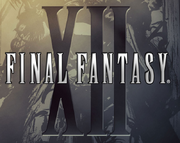
NA Collector's Edition logo.
In North America, the game was available in two versions — the standalone game with a suggested retail price of $49.99 and a "Collector's Edition" for an additional $10. The Collector's Edition is an exclusive title offered only by GameStop or EB Games. This edition includes the original game packaged in a steelbook case, along with a special bonus disc, which contains Final Fantasy XII developer interviews, an art gallery, four U.S. and Japanese trailers, and a "History of Final Fantasy" featurette, which gives brief chronicles on all released and upcoming Final Fantasy games.
Sales and Reception
Final Fantasy XII sold more than 1,764,000 copies in its first week in Japan,[7] and the total number of copies sold was over 2,150,000 after five weeks of release.[8] In North America, Final Fantasy XII shipped approximately 1.5 million copies in its first week.[9] As of March 2007, the game has shipped over 5.2 million copies worldwide[10] and is the fourth best-selling PlayStation 2 game of 2006.[11]
Final Fantasy XII is the first game in the series to get a perfect score from Famitsu Weekly magazine.[12] It was named best PlayStation 2 game by numerous video game publications and websites, including GameSpot, GameSpy, and IGN.[13][14][15] Both Edge Magazine and Famitsu awarded it Game of the Year 2006.[16][17] Final Fantasy XII also received nominations in the categories "Game of the Year", "Best Role-Playing Game", "Best Story", "Best Art Direction", "Best Character Design", and "Best Original Score" from awarding bodies, such as the Interactive Achievement Awards, Game Developers Choice Awards, BAFTA Video Games Awards, Spike Video Game Awards, Golden Joystick Awards, and the Satellite Awards.[18][19][20][21][22][23] The game was awarded the "Double Platinum Prize" at the PlayStation Awards 2006, which was held on 25 July 2006.[24]
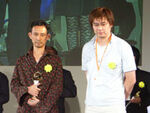
Upon receiving the "Grand Award", Hiroyuki Ito took a photo alongside Hiroaki Kato, the game's Project Manager.
At the Japan Game Awards 2006 held on 22 September 2006, Ito accepted the "Grand Award" and "Award for Excellence" for Final Fantasy XII. He thanked the development team, longtime fans and new players alike, and said the team was grateful for the awards as they could not possibly think about the game's reception during its creation.[25]
In July 2007, Edge Magazine placed Final Fantasy XII 8th in their list "EDGE’S TOP 100 GAMES OF ALL TIME". It was highest ranking Final Fantasy game, and the only one to appear in the top 10.[26] In March 2009, Edge Magazine placed the game 25th in their list "The 100 Best Games To Play Today". As with their former list, Final Fantasy XII was the highest ranking Final Fantasy game.[27] In the 2009 issue of the Guinness World Records Gamer's Edition, the game placed 8th in the list "The Top 50 Games of All Time". It was the highest ranking Final Fantasy game, and the only one to appear in the top 10. The list was decided on by "a crack team of industry experts", and games were ranked on their initial impact, lasting legacy, and how fun they were to play.[28]
Manga
The story of Final Fantasy XII has been released as a manga in Japan. The manga version expands on the storyline seen in the game and adds new events and characters.
Allusions
Final Fantasy XII contains many references to the games developed by the same team, or based on the same world. For instance, a moogle named Montblanc runs a clan in Final Fantasy XII, and previously appeared as a main character in Final Fantasy Tactics Advance. Similarly, the player can acquire the Riskbreaker clan rank, a reference to the game Vagrant Story.
The names of the Archadian airships are taken from previous summons from the series, while all of the Resistance airships are named for previously appeared characters. The only airship with an original name is the party's airship, the Strahl.
Packaging Artwork
Template:Gallery
Gallery
Template:Gallery
Trivia
- Final Fantasy XII is only the second main series Final Fantasy game where Cid is biologically related to one of the main members of the party - the other being Final Fantasy X.
- Actor Sir Patrick Stewart narrated the television commercial for the European and Australian versions of the game.[29]
- Veteran voice actor Corey Burton narrated a commercial for the American version of the game.
- Hironobu Sakaguchi, creator of the Final Fantasy series, didn't play the game through to completion because he was disappointed by the departure of the original producer and director, Yasumi Matsuno.[30] However, he later stated that the target lines used in the game were what inspired the creation of the target lines used in his game The Last Story.
- Final Fantasy XII is the only game in the main series that is available on only a singular platform.
See also
- Final Fantasy XII Tips
- Final Fantasy XII/Official Strategy Guide
- Final Fantasy XII Merchandise
- Final Fantasy XII/Allusions
- Final Fantasy XII/Translations
- Final Fantasy XII Wallpapers
References
- ↑ http://archive.videogamesdaily.com/news/200611/034.asp?f=034.asp
- ↑ Final Fantasy 20th Anniversary Ultimania File 1: Character page 466
- ↑ Square Talks Firsts for Final Fantasy XII
- ↑ Final Fantasy's Hiroyuki Ito and the Science of Battle -- 1up.com
- ↑ 5.0 5.1 5.2 5.3 5.4 English translation of Hiroyuki Ito interview from the FFXII: International Ultimania
- ↑ http://uk.ps2.ign.com/articles/742/742013p1.html
- ↑ Japanese Sales Charts, Week Ending March 19
- ↑ News - Japan: Weekly software sales for 4/10 - 4/16
- ↑ SQUARE ENIX ANNOUNCES RECORD SHIPMENT WITH FINAL FANTASY XII
- ↑ http://www.square-enix.com/jp/common/images/sqex_07profile_e.pdf#page=6
- ↑ PS2 2006 Year in Review
- ↑ http://www.1up.com/news/xii-scores-perfect-famitsu
- ↑ http://www.gamespot.com/special_features/bestof2006/platform/index.html?page=6
- ↑ http://bestof.ign.com/2006/ps2/39.html
- ↑ http://goty.gamespy.com/2006/ps2/index11.html
- ↑ http://web.archive.org/web/20070126114821/http://www.edge-online.co.uk/archives/2006/12/final_fantasy_x.php
- ↑ http://www.famitsu.com/game/news/2007/04/20/103,1177037473,70570,0,0.html
- ↑ http://www.interactive.org/awards/2007_10th_awards.asp
- ↑ http://www.gamechoiceawards.com/archive/gdca_7th.html
- ↑ http://web.archive.org/web/20100131020923/http://www.bafta.org/awards/video-games/nominations/?year=2007
- ↑ http://www.gamespot.com/news/oblivion-nabs-spike-tv-top-honors-6162929
- ↑ http://www.edge-online.com/news/golden-joystick-shortlists-announced/
- ↑ http://web.archive.org/web/20100107095753/http://pressacademy.com/satawards/awards2006.shtml
- ↑ http://www.jp.playstation.com/info/release/nr_20060725_awards.html
- ↑ http://awards.cesa.or.jp/2006/ceremony/02.html
- ↑ http://www.edge-online.com/features/edges-top-100-games-all-time/10/
- ↑ http://www.edge-online.com/features/100-best-games-play-today/8/
- ↑ http://www.eurogamer.net/articles/guinness-lists-top-50-games-of-all-time
- ↑ http://www.joystiq.com/2007/02/15/patrick-stewart-to-voice-ffxii-the-ad
- ↑ http://vg-mania.blogspot.com/2010/12/review-final-fantasy-xii-2006.html
External links
- Official Japanese site
- Official North American site
- Wikipedia's entry on Final Fantasy XII
- Final Fantasy XII.net, a fansite
- Final Fantasy XII US - fansite
- Final Fantasy XII at the Final Fantasy Compendium
- VGMdb - Final Fantasy XII Original Soundtrack
Template:FFXII Template:25thcompl Template:Ival Template:Series
ar:Final Fantasy XII

